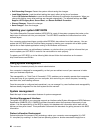
• Exit Discarding Changes: Restart the system without saving the changes.
• Load Setup Defaults: Load the default setting that was in effect at the time of purchase.
Enable OS Optimized Defaults to meet the Microsoft Windows 8 certication requirements. When you
change this setting, some other settings are changed automatically. The affected settings are CSM
Support, UEFI/Legacy Boot, Secure Boot, and Secure RollBack Prevention.
• Discard Changes: Discard the changes.
• Save Changes: Save the changes.
Updating your system UEFI BIOS
The Unied Extensible Firmware Interface (UEFI) BIOS is a part of the system programs that make up the
basic layer of software built into your computer. The UEFI BIOS translates the instructions from other
software layers.
Your computer system board has a module called EEPROM, also referred to as ash memory. You can
update the UEFI BIOS and the ThinkPad Setup program by starting your computer with a ash update
optical disc or ash update application running in the Windows environment.
In some instances when you add software, hardware, or a device driver, you might be informed that you
need to update your UEFI BIOS in order for the new addition to work properly.
To update your UEFI BIOS, go to the following Web site and follow the instructions on the screen:
http://www.lenovo.com/Drivers
Using system management
This section is intended primarily for network administrators.
Your computer is designed for manageability, so that you can redirect more of your resources to better
meet your business objectives.
This manageability, or “Total Cost of Ownership” (TCO), enables you to remotely operate client computers
in the same way as you operate your own computer, such as turning on a client computer, formatting
hard disk drive, and installing software.
Once the computer is congured and operational, you can manage it by use of software and manageability
features already integrated into the client system and the network.
System management
Read this topic to learn more about features of system management:
Desktop Management Interface
The system UEFI BIOS of your computer supports an interface called System Management BIOS Reference
Specication (SMBIOS) V2.6.1 SMBIOS provides information about the hardware components of your
system. It is the responsibility of the BIOS to supply this database with information about itself and the
devices on the system board. This specication documents the standards for getting access to this BIOS
information.
Preboot eXecution Environment
Preboot eXecution Environment (PXE) technology makes your computer more manageable (it is PXE
2.1-compliant) by enabling it to boot (load an operating system or another executable image) from a
88 User Guide


















